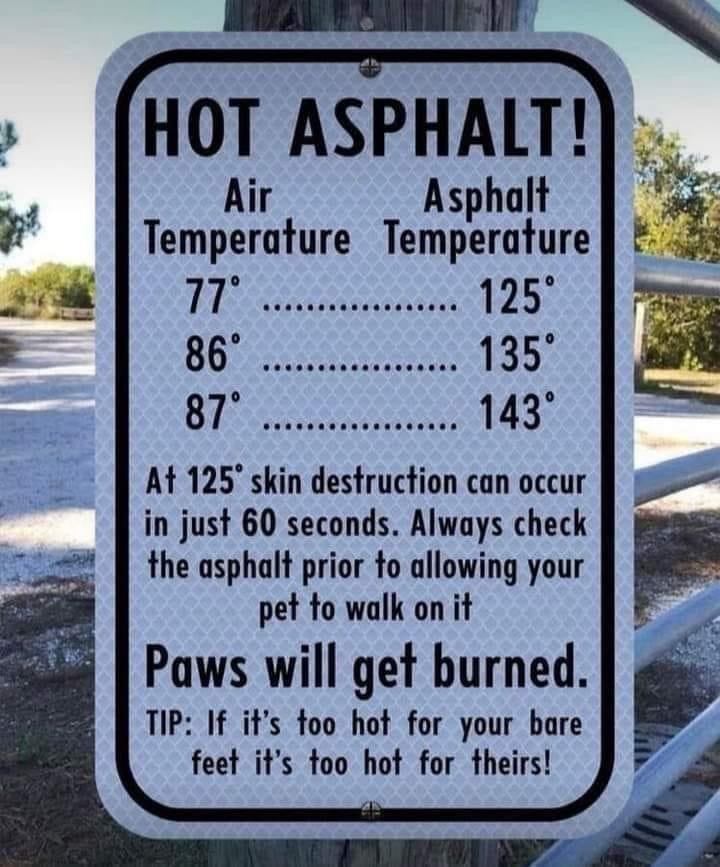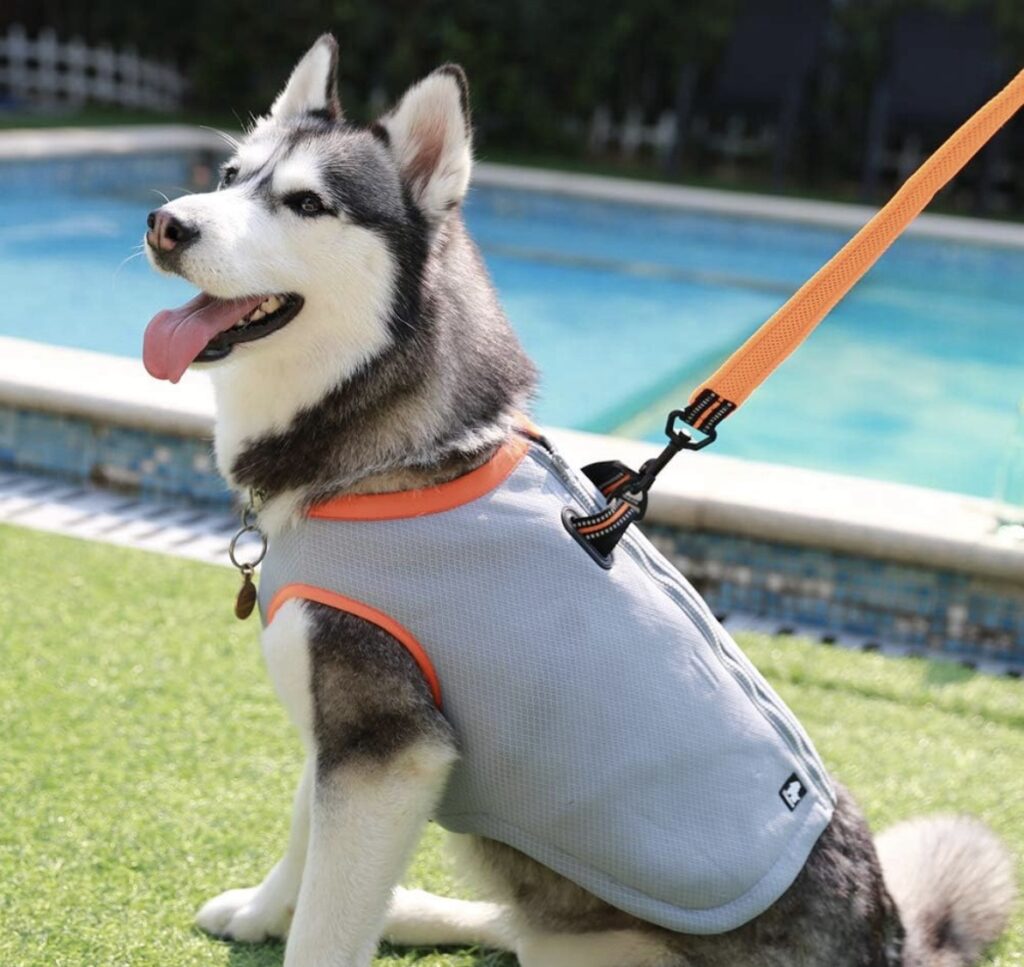Summertime can be a wonderful season for enjoying the outdoors with your furry friend. However, it’s crucial to be aware of the hidden dangers that come with warmer weather, particularly when it comes to hot asphalt. Many pet owners don’t realize just how quickly pavement can heat up and cause severe burns to their pet’s paws. I learned this lesson the hard way, and now I make it a point to always check the pavement before taking my dog for a walk.
Did you know that at 125°F, skin destruction can occur in just 60 seconds? That’s the temperature at which asphalt can become dangerously hot for both humans and pets. It’s a startling fact that underscores the importance of taking precautions during summer walks. Always remember: if it’s too hot for your bare feet, it’s definitely too hot for theirs!
In this article, we’ll explore how asphalt temperatures can rise to dangerous levels, how to recognize when the pavement is too hot for your pet, and what steps you can take to protect your dog’s paws. From understanding the relationship between air temperature and pavement heat to discovering practical tips and essential gear, you’ll be well-equipped to keep your pet safe this summer.

How Hot Asphalt Affects Pets
As temperatures rise, so does the temperature of asphalt and pavement. It’s surprising how much hotter these surfaces can get compared to the air temperature. On a sunny day, asphalt can reach dangerously high temperatures very quickly, posing a serious risk to your pet’s paws.
When the air temperature is 77°F, the asphalt can be a scorching 125°F, hot enough to cause skin destruction in just 60 seconds. At 87°F, the asphalt can reach a blistering 143°F. These temperatures are not only uncomfortable but can also cause severe burns and pain to your pet’s delicate paws. Just imagine walking barefoot on such hot surfaces—our pets feel the same discomfort, if not more.
Understanding these temperature dynamics is crucial for pet owners. It’s not just about the heat; it’s about how quickly that heat can cause harm. Knowing this, I always take extra steps to ensure the pavement is safe for my dog. During one of my summer walks, I noticed my dog hesitating and lifting his paws frequently. I quickly realized the pavement was too hot and immediately took action to prevent any burns.
If you’re unsure about the pavement temperature, there’s a simple test: place the back of your hand on the asphalt for seven seconds. If it’s too hot for you, it’s definitely too hot for your pet. Another way to gauge the temperature is by using an infrared thermometer, which provides an accurate reading of the surface temperature.
This awareness has changed the way I approach summer walks. I now walk my dog early in the morning or late in the evening when the temperatures are cooler and the pavement is safer. Additionally, I always keep an eye out for shaded areas and grassy paths, which are much gentler on my dog’s paws. Understanding and recognizing dangerous pavement temperatures is the first step in protecting your pet from the hidden dangers of hot asphalt.

Recognizing Dangerous Pavement Temperatures
Recognizing when the pavement is too hot for your pet is essential to prevent painful burns and injuries. Even on days that don’t feel overwhelmingly hot to us, asphalt can heat up quickly and become dangerous. Here are some practical tips to help you determine if the pavement is safe for your pet’s paws.
One of the simplest methods to check the pavement temperature is the “bare feet” test. If you can’t comfortably hold the back of your hand on the asphalt for seven seconds, it’s too hot for your pet to walk on. This quick test has saved my dog from many potential burns. On particularly sunny days, I make it a point to test the pavement frequently, especially before we start our walk.
Another effective tool is an infrared thermometer, which can measure the exact temperature of the pavement. These devices are easy to use and provide instant, accurate readings. By pointing the thermometer at the asphalt, you can get a clear idea of whether it’s safe for your pet. I’ve found that using an infrared thermometer gives me peace of mind, knowing that I’m taking an extra step to ensure my dog’s safety.
If you’re interested in getting one, here’s a reliable option available on Amazon: Infrared Thermometer. It’s a small investment that can make a big difference in keeping your pet safe.
During the hottest parts of the day, typically from 10 a.m. to 4 p.m., it’s best to avoid walking your pet on asphalt altogether. Instead, opt for early morning or late evening walks when the ground is cooler. This not only protects your pet’s paws but also reduces the risk of heatstroke, which can be life-threatening.
I also pay attention to the route we take. Shaded areas and grassy paths are much safer for pets compared to bare asphalt. Parks with lots of trees or trails with natural ground cover are ideal for summer walks. If you’re in an urban area, try to find routes that offer some shade or consider using a pet stroller for parts of the journey where there’s no alternative to asphalt. You can find a variety of pet strollers designed for comfort and safety, such as this one on Amazon: Pet Stroller.
Recognizing and avoiding dangerous pavement temperatures is a critical part of being a responsible pet owner. By taking a few extra precautions, you can ensure that your furry friend stays safe and enjoys their outdoor adventures without risking painful burns.

Protective Gear for Hot Pavement
To ensure your pet’s safety during summer walks, investing in protective gear is essential. There are several products designed to protect your dog’s paws from the scorching pavement, and using them can make a significant difference.
One of the best investments I made was in a pair of dog booties. These booties are designed to shield your pet’s paws from hot surfaces, rough terrain, and even cold weather. I chose the QUMY Dog Shoes for Large Dogs. These booties are durable, comfortable, and provide excellent protection against the heat of the asphalt. They have a non-slip sole, which is great for all types of surfaces, and they stay securely on my dog’s paws during our walks. Here’s a link to check them out: QUMY Dog Shoes for Large Dogs.
Another fantastic product is paw wax. Paw wax can be applied to your dog’s paw pads to create a protective barrier against hot surfaces. I use Natureland Organic Paw Wax, which is made from natural ingredients and helps to heal, repair, and protect dry or chapped paws. It’s easy to apply and provides an extra layer of defense against the heat. You can find it here: Natureland Organic Paw Wax.
In addition to paw protection, keeping your dog cool is crucial. One of my favorite products for this is the Truelove Dog Cooling Vest. This vest works by reflecting heat and providing a cooling effect through evaporation. It’s easy to put on and adjust, making it perfect for hot summer days. Not only does it help regulate your dog’s body temperature, but it also makes our walks much more comfortable. Check out the cooling vest here: Truelove Dog Cooling Vest.
When walking on hot days, always carry a portable water bottle for your dog. Hydration is key to preventing heatstroke and keeping your pet comfortable. There are many great options available, but one of my favorites is a portable water bottle with an attached bowl. It’s convenient and ensures my dog always has access to fresh water. Here’s a link to a reliable portable water bottle: Portable Water Bottle.
Using protective gear not only helps prevent burns and injuries but also makes summer outings more enjoyable for both you and your pet. With the right preparations and gear, you can safely explore the outdoors without worrying about the risks associated with hot pavement.
Taking these precautions and using the recommended products have made a huge difference in our summer walks. By investing in quality protective gear, you can ensure your pet stays safe and comfortable, even on the hottest days.

Additional Summer Pet Safety Tips
While protecting your pet’s paws from hot asphalt is crucial, there are other important steps to ensure their overall safety and comfort during the summer. Here are some additional tips to keep your furry friend cool and happy in the heat.
Hydration is Key: Keeping your pet hydrated is essential, especially on hot days. Always carry a portable water bottle when you’re out and about. I use one with an attached bowl, which makes it easy to offer my dog a drink anytime, anywhere. This simple practice has prevented many potential heat-related issues. Check out this reliable portable water bottle: Portable Water Bottle.
Provide Plenty of Shade: Whether you’re in your backyard or at a park, ensure your pet has access to shaded areas. Shade helps keep pets cool and prevents overheating. Portable shade tents can be particularly useful for outings and are easy to set up. Creating a cool resting spot is essential during breaks in your outdoor activities.
Use Cooling Mats and Bandanas: Cooling mats provide a great way for pets to cool down after a walk or play session. These mats are filled with a gel that absorbs heat and provides a cooling effect. I’ve found that my dog loves lying on a cooling mat after a long walk. Cooling bandanas are another excellent option. Soak them in water and tie them around your dog’s neck for a refreshing cool-down. Here’s a cooling mat that I recommend: Cooling Mat.
Avoid Peak Heat Hours: The hottest part of the day is typically between 10 a.m. and 4 p.m. Try to schedule walks and outdoor activities in the early morning or late evening when temperatures are cooler. This not only protects your pet’s paws but also reduces the risk of heatstroke.
Indoor Activities: On particularly hot days, it’s best to keep your pet indoors. Engage them with indoor activities to keep them entertained. Brain games and puzzle toys are great for mental stimulation and preventing boredom. I found these suggestions helpful in the article 6 Best Toys to Combat Boredom in Dogs.
Regular Grooming: Keeping your pet well-groomed can help them stay cool. Regular brushing helps remove excess fur and promotes better air circulation to the skin. However, avoid shaving their fur too short, as it provides natural protection against sunburn.
Watch for Signs of Heat Stress: Be vigilant for signs of overheating, such as excessive panting, drooling, lethargy, and uncoordinated movements. If your pet shows any of these symptoms, move them to a cooler area immediately and provide water. Applying cool (not cold) water to their paws and belly can help lower their body temperature.
Use Natural Remedies for Anxiety: Heat can increase anxiety in some pets. Natural remedies can help calm anxious pets, making them more comfortable in hot weather. For tips on managing anxiety naturally, refer to the article Natural Remedies for Anxiety in Dogs.
Following these summer safety tips ensures that your pet stays healthy and happy even in the heat. By combining proper hydration, shade, protective gear, and indoor activities, you can enjoy the summer months without putting your furry friend at risk.

Safe Walking Practices
Walking your pet during the summer requires a few extra precautions to ensure their safety and comfort. Here are some practical tips to help you plan safe and enjoyable walks with your furry friend.
Best Times of Day for Walks: The early morning and late evening are the safest times to walk your pet during the summer. During these cooler hours, the pavement has had a chance to cool down, and the air temperature is more comfortable. I typically schedule our walks around sunrise or sunset, which not only helps avoid the heat but also makes for a more pleasant experience overall.
Choose Shaded Routes: When planning your walking route, look for paths that offer plenty of shade. Parks with tree-lined trails or urban areas with shaded sidewalks are ideal. This helps keep the pavement cooler and provides a more comfortable walking environment for your pet. I always scout for shaded routes before our walks to ensure my dog stays cool.
Grass and Natural Ground: Whenever possible, opt for walking on grass or natural ground instead of asphalt. Grass is much cooler and gentler on your pet’s paws. If you’re in an urban area, try to find parks or grassy patches along your route. My dog loves walking on grass, and it significantly reduces the risk of paw burns.
Use a Pet Stroller: For longer walks or when there’s no alternative to asphalt, consider using a pet stroller. A pet stroller allows your dog to enjoy the outdoors without risking burns from hot pavement. This can be especially useful for older dogs or those with mobility issues. Here’s a great option for a pet stroller: Pet Stroller. It provides comfort and safety, allowing you to explore without worry.
Avoid Busy Streets: Try to avoid walking your pet on busy streets during peak hours. Not only can the pavement be dangerously hot, but the increased traffic can also be stressful for your pet. Quieter, residential areas or dedicated walking paths are better choices.
Monitor Your Pet’s Behavior: Keep a close eye on your pet during walks. If they start to show signs of discomfort, such as lifting their paws frequently, panting heavily, or trying to seek shade, it’s time to take a break. Find a shaded spot and offer them water. Listening to your pet’s cues is key to preventing heat-related issues.
Keep Walks Short: On particularly hot days, keep walks short and sweet. A quick stroll to allow your pet to relieve themselves and get some fresh air is often enough. Longer walks can be reserved for cooler days or times when you can ensure their safety.
Plan Indoor Activities: When the weather is too hot for outdoor walks, engage your pet with indoor activities. Brain training games and puzzle toys are excellent for mental stimulation. I found helpful tips in the article Unleashing Your Dog’s Hidden Potential with Brain Training. These activities keep my dog entertained and exercised without exposing them to the heat.
First Aid Kit: Always carry a basic first aid kit with you on walks. Include items like paw wax, bandages, and a small bottle of water. This can be a lifesaver in case of minor injuries or if you need to cool down your pet quickly.
Implementing these safe walking practices ensures that your pet remains comfortable and protected during summer outings. By being mindful of the temperature, choosing appropriate routes, and monitoring your pet’s behavior, you can enjoy safe and enjoyable walks all season long.

Engaging Indoor Activities
When the summer heat makes it unsafe to venture outside, keeping your pet entertained and mentally stimulated indoors is essential. Here are some engaging activities and tips to help your dog stay happy and active without stepping on hot pavement.
Interactive Toys and Puzzles: Interactive toys and puzzles are fantastic for keeping your dog’s mind sharp. These toys challenge your pet to think and problem-solve, which can help combat boredom and anxiety. One of my dog’s favorites is the treat-dispensing puzzle toy. It keeps him occupied for hours as he figures out how to get the treats. For more ideas, check out the article on 6 Best Toys to Combat Boredom in Dogs.
Brain Training Games: Engaging your dog in brain training exercises is a great way to stimulate their cognitive abilities. Simple games like hide and seek, or more complex activities like training sessions using new commands or tricks, can be both fun and rewarding. I found the tips in Unleashing Your Dog’s Hidden Potential with Brain Training incredibly useful. These exercises help keep my dog mentally active and strengthen our bond.
Indoor Fetch and Tug-of-War: If you have enough space, playing fetch or tug-of-war indoors can provide good physical exercise. Use soft, lightweight balls or toys to avoid damaging furniture. My living room becomes a mini playground where we can play safely away from the heat.
Scent Games: Dogs have an excellent sense of smell, and scent games are a great way to engage this natural ability. Hide treats around the house and encourage your dog to find them. This game provides mental stimulation and taps into their natural hunting instincts. It’s a fun and easy way to keep them entertained.
Teaching New Tricks: Use the indoor time to teach your dog new tricks. Whether it’s rolling over, playing dead, or even more practical commands like fetching specific items, teaching new tricks is a productive way to spend time together. Plus, it mentally engages your dog and builds their confidence.
Calming Activities for Anxious Dogs: Hot weather and being confined indoors can sometimes increase anxiety in dogs. Providing calming activities and natural remedies can help. Gentle massage, soothing music, and natural anxiety remedies can make a big difference. For more on this, check out Natural Remedies for Anxiety in Dogs.
Interactive Feeding: Use interactive feeders or food puzzles to make mealtime more engaging. These feeders slow down eating and provide mental stimulation as your dog works to get their food. It’s an easy way to turn a routine activity into a fun challenge.
Creating a Comfortable Environment: Ensure your home environment is comfortable for your dog during hot weather. Use fans or air conditioning to keep the room cool, and provide a cooling mat where they can rest. These mats offer a cool spot for your dog to lie on and help regulate their body temperature. Here’s a link to a recommended cooling mat: Cooling Mat.
Hydration Stations: Set up multiple hydration stations around your home. Make sure your dog always has access to fresh water, especially during the summer months. A portable water bottle with an attached bowl is also handy for keeping them hydrated indoors.
By incorporating these engaging indoor activities, you can ensure your dog stays happy, healthy, and mentally stimulated even when it’s too hot to go outside. These activities not only provide physical and mental exercise but also strengthen the bond between you and your furry friend.
Managing Heat-Related Anxiety
Summer heat can sometimes exacerbate anxiety in dogs, making it important to manage their stress levels effectively. Here are some tips and natural remedies to help keep your pet calm and comfortable during the hot months.
Create a Calm Environment: Ensure that your home provides a peaceful retreat from the heat. Use fans or air conditioning to keep the room cool and comfortable. I find that playing soft, soothing music can help create a calming atmosphere for my dog. Keeping the blinds or curtains closed during the hottest part of the day can also help maintain a cooler indoor environment.
Use Natural Calming Remedies: Natural remedies can be very effective in reducing anxiety. Products like CBD oil, chamomile, and valerian root can help soothe an anxious dog. I’ve used calming sprays and diffusers with essential oils like lavender and chamomile, which have a relaxing effect on my dog. For more information on natural remedies, check out the article on Natural Remedies for Anxiety in Dogs.
Comfort Items: Providing comfort items like your dog’s favorite blanket or toy can help reduce anxiety. Items that carry your scent can be particularly soothing. I always ensure my dog has his favorite stuffed toy nearby during stressful times.
Regular Routine: Maintaining a regular routine can help alleviate anxiety. Regular feeding times, consistent walks during cooler hours, and structured playtime provide a sense of security and predictability for your dog. I try to stick to our routine as closely as possible, even during the hottest days.
Interactive Toys and Puzzles: Keeping your dog mentally stimulated with interactive toys and puzzles can distract them from anxiety. These toys challenge their mind and provide a positive outlet for their energy. My dog loves treat-dispensing toys that keep him occupied and engaged. You can find some great options in the article 6 Best Toys to Combat Boredom in Dogs.
Cooling Gear: Using cooling products like the Truelove Dog Cooling Vest can help keep your dog comfortable and reduce heat-related stress. The cooling vest works by reflecting heat and providing an evaporative cooling effect, making it an excellent choice for hot days. Check out the cooling vest here: Truelove Dog Cooling Vest.
Hydration and Nutrition: Keeping your dog hydrated is crucial. Make sure they always have access to fresh water. Adding ice cubes to their water bowl can make drinking more appealing. Additionally, consider adding fish oil to their diet. Fish oil has numerous health benefits, including reducing inflammation and promoting a healthy coat, which can help your dog feel more comfortable in the heat. Learn more about the benefits in the article The Benefits of Fish Oil for Dogs.
Quiet Spaces: Provide a quiet, safe space where your dog can retreat if they feel anxious. A cozy corner with a comfortable bed or a crate can offer a sense of security. My dog often retreats to his bed in the corner of the living room when he needs a break from the hustle and bustle.
Exercise During Cooler Hours: Ensure that your dog gets enough physical activity during the cooler parts of the day. Morning and evening walks not only prevent overheating but also help burn off excess energy that can contribute to anxiety.
By implementing these strategies and using natural remedies, you can effectively manage your dog’s heat-related anxiety. Keeping them calm and comfortable during the summer months ensures they stay happy and healthy, despite the high temperatures.
As an Amazon Associate we earn from qualifying purchases through some links in our articles.




